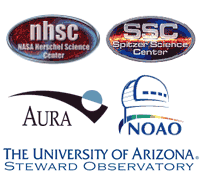Sponsored by NOIRLab, NHSC, SSC, Aura astronomy, and the University of arizona.
We would like to bring your attention to the MGCT3 blog, which you can access at:
The blog has been populated with one post for each Session. We hope that you will add your ideas for discussion topics at any time, starting now. No login is necessary. Simply find the relevant session and post your idea as a comment. Since you will have internet access in the meeting room, you can add your ideas as they occur to you during the meeting. The discussion leaders will use your input as a resource for focusing the discussion towards topics that are of particular interest to the audience. The format is very free-form, so be creative and let us know what you would like to get out of the discussion.
It is now well established that the bulk of stars that constitute the old populations in present-day massive galaxies were formed at high redshift. However, it is not clear under what conditions this early star formation occurred. Observations with the Spitzer Space Telescope have revealed that much of the star-formation at high redshift takes place in dusty galaxies with very high infrared luminosities. In addition, there is a growing awareness that many factors may regulate the progress of star formation in galaxies (e.g., the accretion of gas through either continuous or discrete events; feedback from the growth of black holes and / or star formation; environmental effects, etc.). With the availability of new data from IR space telescopes (Spitzer, Herschel and WISE), the imminent availability of new ground-based capabilities for probing gas and dust in high-redshift galaxies, and the recent improvements in theoretical simulations, it is timely to revisit our theoretical and observational understanding of star-formation in galaxies at their epoch of peak activity. What do the state-of-the-art observations tell us about the formation, assembly, and activity in galaxies at this peak epoch, in particular about the fueling of star- and AGN-formation in galaxies? What do theoretical models predict for the physical state of gas and dust in high-redshift galaxies and what types of observations can best discriminate between competing paradigms for galaxy formation and assembly? What can be learned about the physical conditions in these distant luminous galaxies from studies of more local galaxies?
We propose to hold a workshop focusing on these issues, and in particular on the new observations resulting from Herschel, WISE, and Spitzer, and the potential of the new and revitalized ground- and space-based telescopes. The format will follow that of our prior two successful MGCT workshops (~50 participants, focused sessions, lots of time for discussion).
Some history:
The first MGCT workshop was held at STScI in 2004 and dedicated to exploring the census and origin of the most massive galaxies from high redshift to the present day. In particular, the workshop focused on resolving the disconnect between observations and theory regarding the formation of the most massive galaxies. The second MGCT workshop was held in Tucson in 2006 , and focused on the emergence of the red sequence, the growth of mass, star-formation and accretion histories of the most massive galaxies, and in particular brought into the discussion the new observations from ground- and space-based deep- and wide-field surveys. This third meeting will continue the MGCT tradition, focusing more on the gas accretion in high-redshift galaxies.
